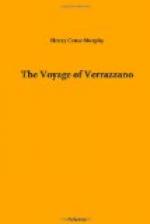In November, 1522, a vessel arrived in Spain which had been sent from Mexico, by the conquistador with the emperor’s share of the tribute money collected in that country, in the special charge of Alonzo Davila and Antonio Quinones, with other articles of value. Fearing capture by the French corsairs, this vessel had sailed by the way of the Azores, and leaving the treasure, with its custodians, at the island of Santa Maria, proceeded on without it, in order that a proper force might be sent to that island to bring it safely to Spain. Joan Ribera, the secretary of Cortes, came in the ship to Spain. These facts appear to have become notorious immediately. Peter Martyr mentions them in his letter of the 17th of November 1522, and in the fifth of his decades, written while the treasure was still at Santa Maria, speaks of the French having knowledge of its being left there. “I know not,” he says, “in reference to the ships sent there for it, what flying report there is that the French pirates have understood of those ships, God grant them good successe.” [Footnote: Dec. v. c. 10. (Lok’s trans.)] Three caravels were despatched from Seville to Santa Maria, under the command of Captain Domingo Alonzo, arriving there on the 15th of May 1523. Davila and Quinones immediately embarked in them, with the treasure, sailing directly to Spain. Meanwhile, Verrazzano proceeded with six vessels towards Cape St. Vincent, for the purpose of intercepting them, which he succeeded in doing, within ten leagues of that cape. After a sharp encounter, in which Quinones was killed, he captured two of them, in one of which Davila was taken with the gold, and the other most valuable articles. The third caravel escaped, and arrived in Spain, with a tiger and various articles of rich manufacture, which had belonged to Montezuma. Verrazzano took his prizes into Rochelle. The value of the treasure and articles taken was estimated at more than six hundred thousand ducats, or one million and a half of dollars. [Footnote: Peter Martyr, Dec. v. c. 8. Epist. 771, Nov. 19, 1522, and 779, June 11, 1523 (ed. 1670). Herrera, Dec. III. lib. Iv. c. 20. Letter of Davila to the emperor from Rochelle, June 17, 1523, in the archives at Seville, now first published in the Appendix (iv). Martyr says there were two ships, the larger of which only containing the treasure fell into the hands of John Florin, the French pirate, and the others escaped; but Davila must be right.]




